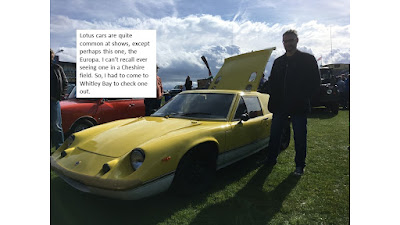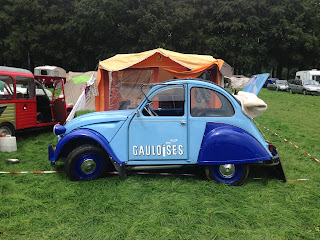It's time to talk about the Citroen SM. I’ve briefly referenced this car a few times over the years. And, of course, it’s from a manufacturer that I admire, as you all know. However, I didn’t have any plans to take up this subject until I was out and about recently and saw a fully restored gold SM outside Whitegates Garage in Davenport in south Manchester.
Now, these are rare cars. Citroen only made around 13,000 from 1970-75. There are so few around that to see one accidentally when you are out doing some errands is akin to seeing a Unicorn. I immediately slammed on my brakes and circled back to see if it really was an SM sat on a side street in a Stockport suburb.
And there it was. In all its retro-futuristic glory. An object that is at once a seventies icon and a spaceship from a distant sexy planet. You can’t help but admire it, even if you don’t know what it is you’re looking at. That was the moment I knew I wanted to write some more about this car.
 |
| Citroen SM Opera - special body - note four doors |
Arguably, the SM is the only true GT car Citroen ever made. Indeed SM stands for Sport Maserati. A Citroen capable of high-speed, transcontinental travel in style and comfort. Square-jawed men in velvet tuxedos could sweep their model girlfriends to the south of France, chain-smoking Gitanes and never look anything other than super cool.
Some claim the SM is the sports version of the DS. It’s true these cars do share a lot of DNA, but in many ways, they are very different vehicles. To make the SM Citroen made some very bold decisions in both the engineering and styling. Foremost of which was the engine. In 1968, Citroen didn’t have a high-performance engine in its stable. The best it had was the ageing 2.1-litre, four-cylinder unit from the DS. But this was more a workhorse than a true sports engine.
Luckily, Citroen owned Maserati at the time of the SM’s development so could access some proper sporty kit. They were able to chop down a Maserati eight-cylinder engine to create a lightweight 2.7-litre, six-cylinder power plant capable of 170 bhp and a top speed of 140 mph. It could accelerate from 0-60 mph in around 9 seconds. Not too shabby. The same engine was later used in the Maserati Merak.
Once the Italian stuff was sorted, the French madness commenced. Citroen’s engineers got busy grafting the hydro-pneumatic suspension, brakes and steering from the DS into place. Soon the engine bay was as packed as Kim Kardashian’s summer shorts.
 |
| A lot of junk in the trunk - can you see daylight? |
Naturally, the SM was front wheel drive like all Citroens but designed to handle as well as its rear-wheel-drive Italian and German rivals. It had high-powered disc braking all round giving world-beating stopping capabilities. The SM also did the same trick as the DS with the suspension languidly rising to action on the turn of the key, giving an unparalleled ride for a sports coupe.
The SM’s ‘Divari’ steering was a true innovation. It got firmer the faster the car was going to improve straight-line stability. And with fully powered steering with just a single turn lock to lock, it took some getting used to compared with contemporary seventies vehicles. They even gave the SM the swivelling headlights from the DS, housed behind the glass facias that gave the SM its distinctive Gallic nose.
Finally, they enrobed it all in a magnificent, captivating, aerodynamic body. It was like Catherine Deneuve in a sheer silk evening gown. Breathtaking.
Alas, the SM was not the commercial success Citroen had hoped for. A key market they aimed to conquer was North America where bigger engined cars were popular. However, poor market research had overlooked the stringent US car laws with which the SM had to comply. One critical issue was the glass headlight farings were not compliant. Their removal ruined the look of the car and sales were stymied.
The SM did have fans though. Just as idiosyncratic as the car itself. Russian President Leonid Brezhnev, Emperor Haile Selassie and the Shah of Iran all owned SMs. Ugandan dictator Idi Amin had seven of them. The owner that thrills me the most though is my childhood hero, that most seventies of he-men, Lee Majors. The Six Million Dollar Man drove an SM. Now that’s cool!
 |
| Somebody wants an SM |
While I was admiring the Stockport-based SM, the owner was nearby, and we had a chat. It turned out it was for sale. When he told me this news, my heart jumped a little. I also felt a frightened quiver from my wallet. I won’t say the price, but it was certainly keen. And as much as I’d love to own an SM, my logical brain was asking whether I really needed a complicated, ageing, Franco-Italian supercar and all the inevitable troubles that would bring.
The answer, surprisingly, was maybe…
Until next time, happy classic motoring everyone.


































